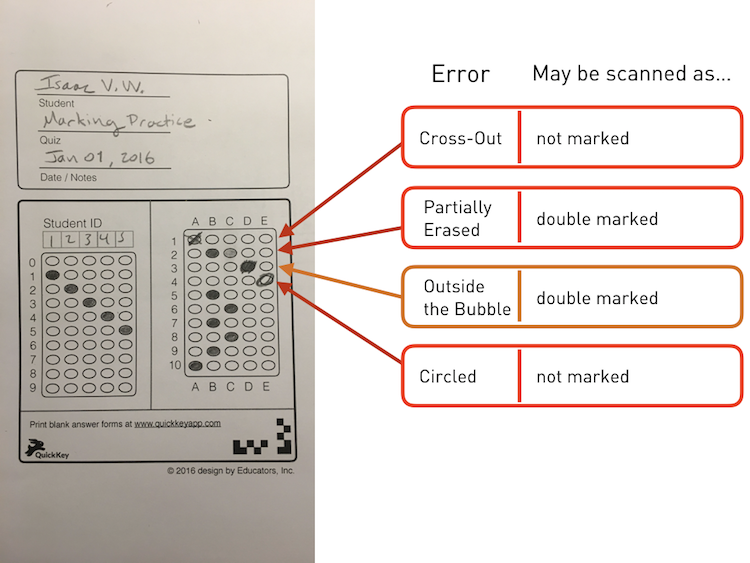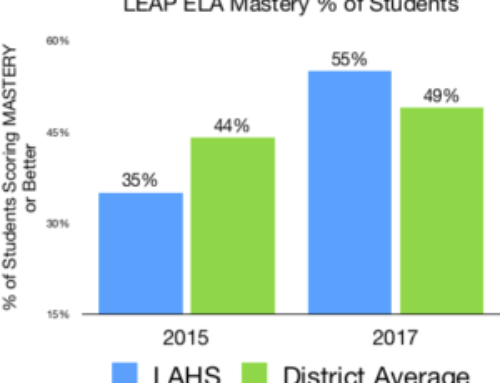The Stakes are High
Students who take standardized high stakes tests on paper can improve their scores significantly by being sure to mark their answers carefully and correctly. According to a study by researchers at Boston College, marking errors can have a meaningful impact on a student’s grade. This, in turn, can have a negative impact on not only that student’s measured progress, but also negatively impact a school or school district’s academic performance rating and even state, federal, and philanthropic funding.
The Good News
The good news is teaching students how to mark their answers on paper standardized high stakes tests can have an immediate positive impact on students, their teachers, and their schools. Given that there are myriad approaches to improving student scores, many of which involve complex and expensive changes to curriculum, class size, and other factors. It’s heartening that the research shows that simply teaching your students how to mark their tests properly is the easiest and most cost-effective way to improve scores by 5-10%.
This doesn’t mean that teachers should cease to use Blooms Taxonomy when planning, or that they shy away from the effort required to improve student achievement through rigorous instruction. What it does mean is that student scores can be more likely to reflect mastery, instead of test taking proficiency.
Better High-Stakes Test Scores: Across-the-Board Impact
For students, higher test scores can mean access to college scholarships and other aid, acceptance to schools of choice, and self-esteem.
Teachers who show improvements in test scores over time may benefit from professional advancement.
Schools and Districts that show improvement on high stakes test scores can access additional funding or prevent loss of funding from state programs and federal programs like Race to the Top.
How to Teach Better Test-Taking for High Stakes Tests and Low Stakes Frequent Formative Assessment
Using a free rapid classroom assessment tool to scan and grade student practice tests and benchmark exams is a fast and effective way to measure and improve students’ test-taking skills and their performance on high stakes tests. As an added bonus, giving your students frequent standards-aligned quizzes is a key component of the Race to the Top Fund.
See what you are scanning
It helps if the paper grading tool you use is mobile and can provide you with a visual of the sheet being scanned while you are scanning it. This way you can see what marking errors the student is making, and also see how the scanner is reading those mistakes. The one caveat is some modern grading apps, like Quick Key, are more effective at dealing with marking errors than are the ScanTron machines used in high stakes testing centers. Therefore, some marking errors that won’t trip up your mobile scanning app might still be a problem come test day. This is why it is very important to be able to see the sheet while you are scanning it.
Look out for common errors, so they don’t occur during high stakes testing
Below is an image showing some of the most common marking errors.
- Cross-Out: most optical mark readers are designed to ignore stray marks. Bubbles that are not completely filled-in may be read as stray marks, rather than answers. Teach your students to fill-in bubbles completely.
- Incomplete Erasures: Especially with the new “Multi-Answer” question types now being used on the Texas STARR, SAT, and other high-stakes tests, mark reading machines are now more than ever prone to reading a poorly-erased mark as a mark, which may result in reduced points for that question, or worse, zero points. Teach your students to choose their answer before they make their mark, and if they do need to erase, to make sure to erase the mark as well as they can. Students can also be directed to make extra sure the answer they do want is marked darkly, and completely.
- Outside the Bubble: Optical mark reading machines get confused when there are stray marks outside of the designated areas of the page (i.e. inside each bubble). To avoid a variety of mis-reading errors, teach your students to keep all their marks inside the bubble, and under no circumstances should they put any marks on the page.
- Circled Bubble: Optical mark readers look for marks inside the bubble. Bubbles that are circled are likely to be read as blank. Teach your students to fill in the bubble, not circle it.
- Faint Marks: Machine scanners work by recording a difference in darkness between blank areas of the page and marked areas. Faint marks are not as dark as well-made marks, and may be mistaken for un-marked bubbles. Teach your students to make sure their marks are dark and completely fill-in the bubble.

Impact two ways
Marking errors can cause up to a 5-10% decrease in test scores. Fortunately, training your students to mark high stakes tests correctly can be done at the same time you make formative assessments for learning. For example, when doing an exit ticket at the end of class, or a weekly quiz. These frequent formative assessment techniques carry their own proven benefits. Additionally, they can end up saving teachers’ time as well as improving student mastery. Long story short: Quiz often, differentiate instruction based on quiz results. Most importantly, if your students will be taking high-stakes tests on paper, then make sure your classroom assessments are on paper too!
Isaac D. Van Wesep is Quick Key’s co-founder and CEO.



